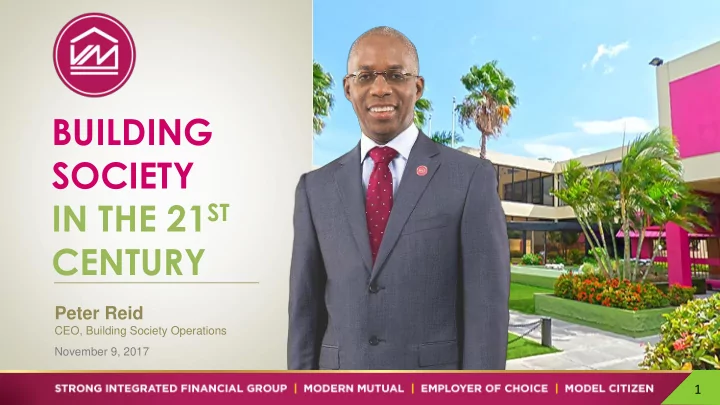

BUILDING SOCIETY IN THE 21 ST CENTURY Peter Reid CEO, Building Society Operations November 9, 2017 1
FINANCIAL INCLUSION “ More than any other financial institution in Jamaica, Victoria Mutual is driven by the mission of achieving financial inclusion. ” - Courtney Campbell 2
HISTORICAL EVOLUTION AND NATURE OF MUTUALS Mutuals are member organisations Membership is derived through ownership of a deposit account or loan which could be a mortgage Mutuals include credit unions, friendly societies, insurance companies, some building societies and even some supermarkets 3
HISTORICAL EVOLUTION AND NATURE OF MUTUALS The mutual building society model originated in the United Kingdom in the 18th century In the 1830s, 'permanent' building societies emerged so that the provision of homes could be extended to more persons 4
BUILDING SOCIETIES AND JAMAICA 1 st Building Society founded in 1864 It is believed that the Kingston Benefit Building Society was the first Credit was given to Rev. William J. Gardner as the founder “Influenced by a few friends anxious to promote the well- being of the working and middle classes” – Gardner,1873 It was understood that the institution was purely mutual in character (not for profit) and provided many people with an excellent home in which they could have obtained no other way 5
HOW DID BUILDING SOCIETIES WORK Persons have to be a Member to participate in the society Consistent saving by Members as the means of purchasing shares over time Members would pool their savings together to buy house and land by borrowing from these funds Accountability and transparency with respect to investments of pooled funds Declaration and sharing of benefits to members as the source of at least the down payment - Errol Miller, 2015 6
HOW WAS THE BUILDING SOCIETY MODEL SOLIDIFIED? Through rapid spread of Building Societies named for the parish in which it was established such as the Westmoreland Building Society Many speculated the political and social environment of the 1870s influenced the spread of Building Societies The socio-economic divisions among the different classes resulting in the Morant Bay Rebellion Victoria Mutual Building Society named for Queen Victoria 7
HOW HAVE THEY SURVIVED? Building Societies not only exist locally, but internationally as well Building Societies have a unique ownership structure One member = one vote Building Societies were constructed with an egalitarian financial model The model supported the lower class who often faced poverty and discrimination based on race and color and helped them climb the social ladder Built on trust and excellent stewardship of funds 8
MODERN MUTUAL An organisation that takes the best of mutual values and the focus on its members and customers to help them achieve their goals. Building on past success to create innovative ways to meet the needs of the 21st century consumers and businesses Helping our Members achieve their purpose State of the art technology - VMBS invested US$18 million in various technology projects Online Mortgage Portal Customer-centric - VMBS recently launched our new service standards 9
CHALLENGES BECOMING A MODERN MUTUAL Raising capital Core Capital Deferred Shares in the UK The Banking Services Act, (2014) allows mutuals to raise capital in a similar way 10
11
CHALLENGES BECOMING A MODERN MUTUAL Competitive Restrictions Real Time Gross Settlement System (RTGS) and Automated Clearing House (ACH) System vs Clearing House Automated Payment System in the UK Chequing Accounts Belief of Lack of Corporate Governance, Service and Efficiency Threat of Hostile Demutualisation 12
OPPORTUNITIES FOR MODERN MUTUAL Increasing competition in the financial sector delivering real value to customers Leading financial inclusion Promoting stability and corporate diversity in the financial market 13
OPPORTUNITIES FOR MODERN MUTUAL Contributing to business development Contribute to the growth of mortgage market $92,271,221,000 as at Dec 2016 this figure excludes Scotia Jamaica Building Society No Customer/Shareholder conflict Model Corporate Citizenship 14
OPPORTUNITIES FOR MODERN MUTUAL Distinguish ourselves through Obsessive Member Focus New Rules enable us to: Expand products offered by the Society Implement more self service channels Be more competitive in the market place 15
CONCLUSION The mutual model has come a long way with many changes but what has remained the same is the unparalleled focus with Members at the forefront of each decision – the future is brighter than ever. 16
CONCLUSION With each change came a wealth of opportunities to our Members which has helped us to meet the needs and wants of a 21 st century consumer. 17
CONCLUSION Above all, these changes have increased competition and subsequently aiding financial inclusion, promote financial and corporate diversity and contribute immensely to the economic growth of the country. 18
Recommend
More recommend